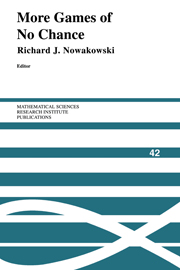Book contents
- Frontmatter
- Contents
- Preface
- The Big Picture
- Idempotents Among Partisan Games
- On the Lattice Structure of Finite Games
- More Infinite Games
- Alpha-Beta Pruning Under Partial Orders
- The Abstract Structure of the Group of Games
- The Old Classics
- Higher Nimbers in Pawn Endgames on Large Chessboards
- Restoring Fairness to Dukego
- Go Thermography: The 4/21/98 Jiang-Rui Endgame
- An Application of Mathematical Game Theory to Go Endgames: Some Width-Two-Entrance Rooms With and Without Kos
- Go Endgames Are PSPACE-Hard
- Global Threats in Combinatorial Games: A Computation Model with Applications to Chess Endgames
- The Game of Hex: The Hierarchical Approach
- Hypercube Tic-Tac-Toe
- Transfinite Chomp
- A Memory Efficient Retrograde Algorithm and Its Application to Chinese Chess Endgames
- The New Classics
- The 4G4G4G4G4 Problems and Solutions
- Experiments in Computer Amazons
- Exhaustive Search in Amazons
- Two-Player Games on Cellular Automata
- Who Wins Domineering on Rectangular Boards?
- Forcing Your Opponent to Stay in Control of a Loony Dot-and-Boxes Endgame
- 1 x n Konane: A Summary of Results
- 1-Dimensional Peg Solitaire, and Duotaire
- Phutball Endgames Are Hard
- One-Dimensional Phutball
- A Symmetric Strategy in Graph Avoidance Games
- A Simple FSM-Based Proof of the Additive Periodicity of the Sprague-Grundy Function of Wythoff's Game
- Puzzles and Life
- The Complexity of Clickomania
- Coin-Moving Puzzles
- Searching for Spaceships
- Surveys
- Unsolved Problems in Combinatorial Game Theory: Updated
- Combinatorial Games: Selected Bibliography With A Succinct Gourmet Introduction
Go Thermography: The 4/21/98 Jiang-Rui Endgame
Published online by Cambridge University Press: 29 May 2025
- Frontmatter
- Contents
- Preface
- The Big Picture
- Idempotents Among Partisan Games
- On the Lattice Structure of Finite Games
- More Infinite Games
- Alpha-Beta Pruning Under Partial Orders
- The Abstract Structure of the Group of Games
- The Old Classics
- Higher Nimbers in Pawn Endgames on Large Chessboards
- Restoring Fairness to Dukego
- Go Thermography: The 4/21/98 Jiang-Rui Endgame
- An Application of Mathematical Game Theory to Go Endgames: Some Width-Two-Entrance Rooms With and Without Kos
- Go Endgames Are PSPACE-Hard
- Global Threats in Combinatorial Games: A Computation Model with Applications to Chess Endgames
- The Game of Hex: The Hierarchical Approach
- Hypercube Tic-Tac-Toe
- Transfinite Chomp
- A Memory Efficient Retrograde Algorithm and Its Application to Chinese Chess Endgames
- The New Classics
- The 4G4G4G4G4 Problems and Solutions
- Experiments in Computer Amazons
- Exhaustive Search in Amazons
- Two-Player Games on Cellular Automata
- Who Wins Domineering on Rectangular Boards?
- Forcing Your Opponent to Stay in Control of a Loony Dot-and-Boxes Endgame
- 1 x n Konane: A Summary of Results
- 1-Dimensional Peg Solitaire, and Duotaire
- Phutball Endgames Are Hard
- One-Dimensional Phutball
- A Symmetric Strategy in Graph Avoidance Games
- A Simple FSM-Based Proof of the Additive Periodicity of the Sprague-Grundy Function of Wythoff's Game
- Puzzles and Life
- The Complexity of Clickomania
- Coin-Moving Puzzles
- Searching for Spaceships
- Surveys
- Unsolved Problems in Combinatorial Game Theory: Updated
- Combinatorial Games: Selected Bibliography With A Succinct Gourmet Introduction
Summary
Go thermography is more complex than thermography for classical combinatorial games because of loopy games called kos. In most situations, go rules forbid the loopiness of a ko by banning the play that repeats a position. Because of the ko ban one player may be able to force her opponent to play elsewhere while she makes more than one play in the ko, and that fact gives new slopes to the lines of ko thermographs. Each line of a thermograph is associated with at least one line of orthodox play [Berlekamp 2000, 2001]. Multiple kos require a new definition of thermograph, one based on orthodox play in an enriched environment, rather than on taxes or on composing thermographs from the thermographs of the followers [Spight 1998]. Orthodox play is optimal in such an environment.
Reading a Thermograph
Many go terms have associations with thermographs. They are not defined in terms of thermographs, but I will be using them in talking about the game, and it will be helpful to be able to visualize the thermographs when I do. The inverse of the slope of a thermographic line indicates the net number of local plays. If one player makes 2 local plays while her opponent makes only plays in the environment, the slope will be plus or minus 1/2. The color of a line indicates which player can afford to play locally at a certain temperature. The player does not necessarily wish to play at that temperature, but she can do so without loss.
In the simple thermograph in Figure 1, the black mast at the top extends upward to infinity. It indicates a region of temperature in which neither player can afford to play locally without taking a loss. The mast starts at temperature, t = 2, which we call the temperature of this game, at the top of the hill. It also indicates the local count (or mast value), which is —5. Just below the top of the hill, the blue line of the Left wall indicates that Black (or Left) will not be unhappy to make a local play in this region of temperature. And it shows what the local score at each temperature would be when Black plays first. Similarly, the red line of the Right wall indicates an initial play by White (or Right).
Information
- Type
- Chapter
- Information
- More Games of No Chance , pp. 89 - 106Publisher: Cambridge University PressPrint publication year: 2002
